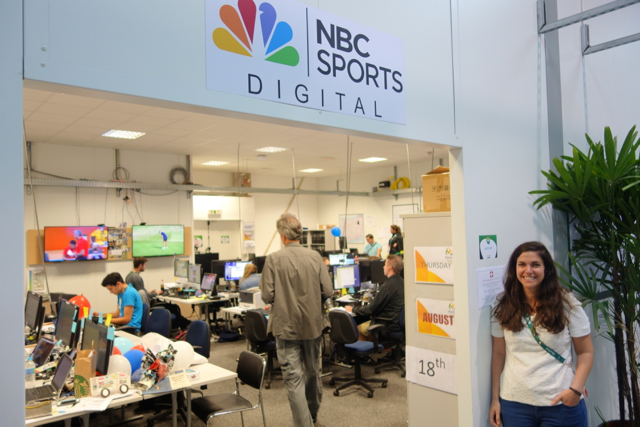Live from Rio 2016: Lyndsay Signor Discusses NBC Olympics Social Strategy
The 2016 Olympics are proof positive that the social media revolution is fully upon us and NBC Olympics is doing its part to make sure its social media team makes the most of the games with efforts on two continents. And like the athletes themselves the NBC Olympics team made good use of the Olympic Trials to find a winning form before descending on Rio.

Lyndsay Signor of NBC Sports says social media efforts for the games are paying off.
“The good thing about the Olympics is we have the Olympic trials to test the interests of the U.S. user and we found very quickly that people can’t get enough of it,” says Lyndsay Signor, NBC Sports, senior director, social media marketing. “So we were testing what were the key things they wanted from us so heading into the Olympics we had a good indication of what kind of things people wanted.”
The NBC Olympics has five people on hand at the IBC in Rio and an upwards of 10 people in Stamford, CT. Signor says that the NBC Sports social media team usually operates as a one-man band operation and in very specific buckets. But the nature of the Olympics, and the sheer tonnage of content and social opportunities, required a move beyond one-man bands.
Three of the social team members are focused on distribution of video on the various social media platforms. Three others are focused on engaging with the platforms via live tweets, Facebook posts, and more. And then there are three graphics designers who create various graphical elements that can be put up quickly onto the different platforms (two of those artists are focused on the Website while the third is focused on social media). Lastly, there is an additional team member who makes sure to distribute any social media posts to relevant interested parties like a specific sport’s U.S. organization and more.
The social media efforts have two key components: those undertaken by the team in Rio and then a second one by the team in Stamford.

The NBC Sports social media team in Rio is focused on the athletes, competitions, and talent that are located in Rio.
“Our team here in Rio is really about finding and creating custom content on the ground, like Snapchat at events or with athletes or talent,” says Signor. “So the Rio team is focused on Rio.”
The major advantage of being in Rio, of course, is that it is where the athletes and NBC talent are located. So one key is figuring out ways to get the athletes and talent involved.
Facebook Live, the social media network’s baked in technology that allows anyone with the Facebook live app on their phone to open the app, click on Facebook Live, and begin streaming live content out via the phones camera and microphone to their Facebook followers via cellular or Wifi service, has proven to be one great tool for both athletes and talent alike.
“Facebook Live is a big initiative for us at these games because we have found on the sports side that there has been of engagement when we make use of athletes and talent,” says Signor.
The social team also identified a natural fit for Facebook Live: during the car ride from a venue to the NBC Olympics studios at the IBC. The cars were outfitted with lighting and sound and Facebook Live broadcasts were able to take place from the road.
“We knew that cellular service might be an issue here in Rio but at least for these we’ve been successful at Facebook Live,” says Signor. “And it’s been the easiest way to do the interviews as anyone from NBC in the car can contact us and we can deliver it to the NBC Olympics Facebook page. So that was a pretty cool thing we’ve done.”
Meanwhile, further north (much further) the NBC Olympics Highlights Factory in Stamford is driving the creation of highlights from event coverage and also finding those top clips that will resonate with not only social media followers of NBC Sports but the federations and athletes themselves who can give content a viral push that can turn it into a phenomenon.
“We like to keep highlights to 45 seconds and under and then shorter moments can be ‘gifable,’” says Signor.
One of the challenges of social media is making sure content for each platform is designed specifically for a given platform. For example, there is a highlights clip quarterback who talks to the highlight factory and helps them understand how to distribute the content out to the various platforms.
“It’s a very well-oiled machine,” says Signor.
The focus for Instagram, for example, is highlights and heavy use of photos while Snapchat is used around live events and on the ground. Facebook, meanwhile, is the place where video does very well.
“If it’s video we’re publishing it to Facebook as that dominates engagement,” says Signor. “On Twitter we’re pushing video and making use of its realtime nature that is more in line with what is on TV.”
The social media stars of the games include a couple of obvious faces, like American gymnast Simone Biles (“anything we put out around her is popular and she is very active on social media,” says Signor) and American swimmer Michael Phelps who is active on Facebook. But then there are the less obvious ones that come out of nowhere, most notably Michael’s infant son Boomer.
“He’s a breakout star and he has no idea,” adds Signor.
The other one is “Angry Michael Phelps Face,” an image that launched a thousand memes and began simply as some video coverage of Phelps in the warm up area prior to a race.
“Those are the kind of things that are unique to the Olympics and give us the ability to have fun and capitalize on moments that are in the periphery of the competition,” says Signor.

